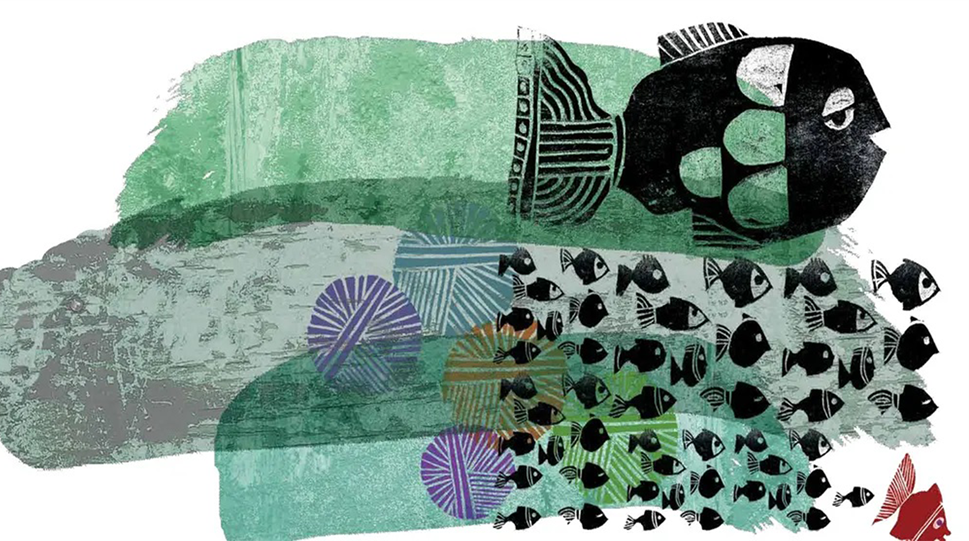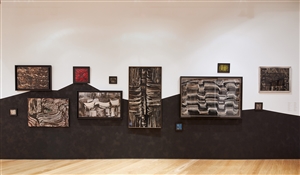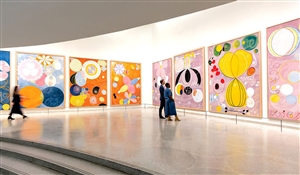"The Little Black Fish"; An Imagination Broad as Farshid Mesghali's Writing
18 Sep 2022Original text in Farsi by Tarannom Taghavi
Translated to English by Omid Armat
As a children's literature work, "The Little Black Fish" by Samad Behrangi is a story in which the writer lets animals express his critical thoughts through cultural metaphors, childish expression, and adult conceptualization. He wrote the story in 1967 amid Iran's social and political changes. In 1968, one month before Behrangi's death, the Institute for the Intellectual Development of Children and Young Adults published the story with illustrations by Farshid Mesghali. It was selected as the best children's book the same year. One year later, the book won the 6th Children's Book Exhibition award in Bologna, Italy. It was also awarded an honorary diploma by the Biennial of Illustration Bratislava for its illustrations.
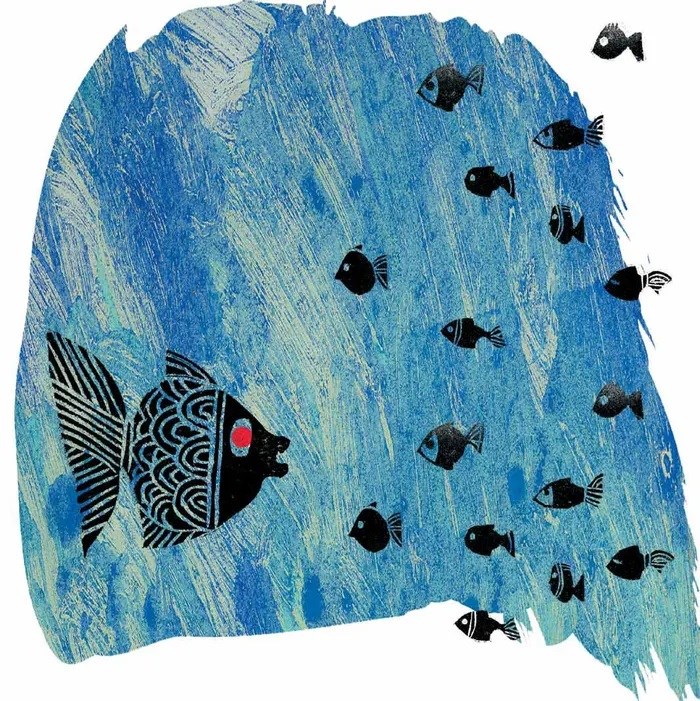
Farshid Mesghali | The Little Black Fish | 1967 | linocut
The story, narrated at Yalda Night (Yaldā Night or Chelle Night is an ancient festival in Iran) by an old fish for its twelve thousand children and grandchildren, is about a little black fish living with his mother in a stream behind a black rock, under a ceiling made of moss that made him sad because it prevented him from seeing the moon. Their daily life involved commuting in a limited space along with other fish. Tired of these repetitive commutes, one morning, the little fish told his mother what he thought: "I want to see where this stream ends… because everything ends, doesn't it?" By threatening and begging, the mother and others tried to dissuade him from pursuing his plan, but the little fish left them and began his journey to explore the unknown. On his path, he meets different creatures like the frog, the wise lizard, the opportunist crab, self-conceited flounders, the wounded gazelle, people, and the pelican. At the end of his risky journey, he arrives at the sea and meets with a group of fish that had taken the same trip and are now known as the shoal of salmons. As the little fish reaches the water's surface before joining them, a heron hunts him. He deceives the heron and runs from its beak, but the heron catches him again and swallows him. This time, he risks his life by saving a little fish and killing the heron. The story, with no clear indication of the little fish's fate, ends with the disappearance of a little red fish.
"The Little Black Fish" is the third children's book illustrated by Farshid Mesghali under commission by the Institute for the Intellectual Development of Children and Young Adults1. During his professional life, Mesghali used various methods, such as lithography, collage, watercolor, and other artistic means to illustrate books. For "the Little Black Fish," he created everlasting images using carving on linoleum and printing in a limited color pallet based on the story's theme. He says, "this book was an engraving experience, and I colored its different parts with my hand. For example, I put black color where it should be black and red color where it should be red. Then I made a print copy or put colors again."2 The print Molds also seem to have had a strange fate; Mesghali mentioned in an interview that the original molds for the book went missing from the institute, but years after the Iranian revolution, a man from the US appeared and sold them again to the institute3.
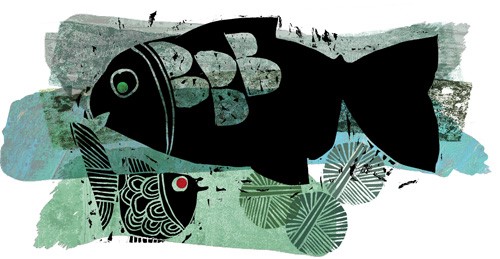
Farshid Mesghali | Little Black Fish 3 | 1967 | linocut | 20 × 60 cm
At first glance, the viewer faces huge images mixed with the text. After an image that displays the little black fish on a green background, one sees another picture of the scene where the mother and son are talking. The mother is rendered in black and has huge dimensions on the top part of the image, and the little black fish is on the bottom part of the image, in front of her mother. The child's scales are ordered and patterned more clearly than his mother's, and his pupil is symbolically colored red, while his mother's pupil is green. Three round decorative elements are printed near the end of the mother's body, which may symbolize the confused course of their life or the restrictions imposed on thoughts. The background is colored with stripes of blue and green as a sign of water's depth, and cut lines in a tight space represent their life's limited space. The artist has successfully used the small dimensions of the little fish's house to show his limits. One interesting thing to note is that by assigning a name to the little fish, the writer has specified his particularities, helping the viewer identify him from other fish. He is tiny and black. However, in the book's illustrations, all creatures, especially all fish, are black and sometimes smaller than the little black fish. The artist has used the body form and scales of the little black fish as his distinguishing features.

Farshid Mesghali | Little Black Fish 8 | 1967 | linocut | 20 × 60 cm
In the following image after the one displaying the little black fish individually, he faces three other fish, surrounded tightly in a small space which may symbolically represent their limited freedom of thought. Their surprised eyes, widely opened compared to the little fish's eye, creates a sense of foolishness and ignorance. Again, three of the same round elements are printed between the little fish and the other fish. The following images show the little fish facing other creatures, from flounders, black like the little fish, moving orderly in a massive shoal within the stream, to the black frog sitting on a brown rock and the black crab with its raised claws conveying a sense of violence and aggression.
In one of the images, where a lizard with green dots on its body is sitting on a rock, one can see two red flowers and a green leaf outside the water for the first time. The black lizard supportively warns the little fish about the dangers of his journey and gives him a dagger with which he can defend himself against the pelican. The green dots on the lizard's body and the peaceful nature around it seem to have been deliberately implemented by the artist to refer to the lizard's goodwill. The dagger is rendered in black in the image on the next page. Although the lizard creates the dagger with plant prickles, it is represented as a human tool made of steel.

Farshid Mesghali | Little Black Fish 6 | 1967 | linocut | 20 × 60 cm
Humans are mentioned four times throughout the story. However, humans have a marginalized presence in all four cases, and no relationship is formed between the fish and humans; the shepherd who takes his herd of sheep to the pond, the fisherman whose net is taken by salmons to the depth of water, the children who play by the stream, the girls who take water, and eventually, the dialogue between the little fish and the moon where they talk about the human's first trip to the moon, none of which has been rendered by the artist as he has evaluated the human with an unimportant position in his illustrations.
In the next image, where the fish faces a vast nature outside the stream for the first time, a gazelle is drinking water in the jungle. From here, the following illustrations lead the reader to the end of the story, where there is an illustration showing the old fish narrating the story; the little black fish in a blue, patterned background in front of a shoal of other fish, an image of the sky meeting the water and the moon over the little fish's head, the pelican's body occupying the whole page while its eyes and the red color of its beak is a symbol of violence, an image of the heron, holding the little black fish in its beak, and another image where he is talking to another little fish inside the heron's body.
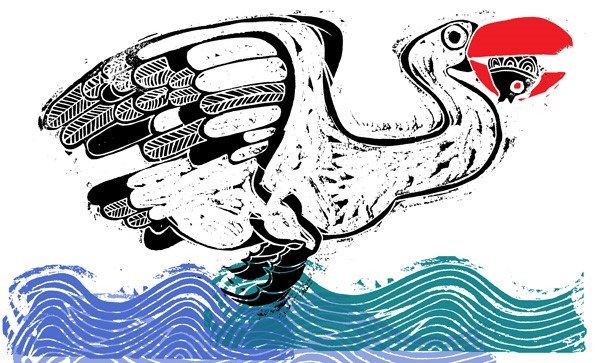
Farshid Mesghali | Little Black Fish 4 | 1967 | linocut | 20 × 60 cm
In the last illustration, which appears as the climax of the story images, the old fish is rendered enormous over a shoal of small fish, behind which one can see the round objects again. There is only one red fish among them, a bit larger than the others, leaving the shoal and moving toward the light in the white background. The red color of the little black fish's eyes seems to have influenced the red fish's life, symbolizing the sun's rebirth after the darkness of Yalda night. The artist wisely illustrated all fish in black to contrast, in the end, between them and the small red fish, represented as a symbol of resistance and overcoming the darkness.
1. Prior to this, he illustrated two books titled "Uncle Nowruz" and "Jamshid Shah" at the Institute for the Intellectual Development of Children and Young Adults.
2. For more information, see "Report of the 6th edition Criticism of Visual Works: Review of Illustrations of the 1960s", "Ketabe Maah; Children and Young Adults", winter 2001, p. 64-82.
3. Kourosh Safinia, Interview with Farshid Mesghali: "Behind the childhood years", Mahnāmah 7, No 20, p. 46-52.
Cover and slider image:
- www.theguardian.com



